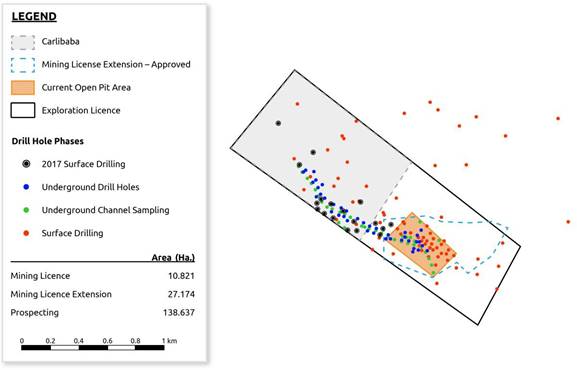Vast Resources, AIM-listed mining company with mining operations in Romania and Zimbabwe, has announced an update to the previously published JORC Compliant Mineral Resource Estimate for its 100% owned producing Manaila polymetallic mine (MPM) in Romania following the completion of 19 surface diamond drill holes in 2017 – see map. This has been undertaken by Craig Harvey, Chief Operating Officer and newly appointed Director and is based upon the inclusion of the 19 surface diamond drill holes and the validation and subsequent inclusion of historical data.
Total open pit Mineral Resource (Indicated & Inferred) is now 4.6Mt (representing an overall increase of 78% to the July 2016 estimate) at a grade of 0.97% Cu, 0.32% Pb, 0.68% Zn, 25.8g/t Ag and 0.23g/t gold (“Au) at a 0.25% Cu cutoff. The open-pit mineral resources in the Measured and Indicated category (all Indicated) of 3.589Mt represent an increase of 209%.
Total underground Mineral Resource (Indicated & Inferred) is now 1.1Mt (representing an overall increase of 249% to the July 2016 estimate) at a grade of 1.58% Cu, 0.82% Pb, 0.88% Zn, 14.6g/t Ag and 0.15 Au at a 1.00% Cu cutoff. The underground mineral resources in the Measured and Indicated category (all Indicated) of 0.399Mt represent an increase of 299%.
The implied mine life is in excess of 11 years based on open pit and underground Measured & Indicated Mineral Resources mined at a rate of 30,000 t/month. Exploration Target defined for:
o Open pit of 1.1-3.2 Mt with grades ranging between 0.4-1.1% Cu, 0.1-0.4% Pb and 0.2-1.1% Zn
o Underground of 7.9-23.6 Mt with grades ranging between 0.4-1.3% Cu, 0.2-0.7% Pb and 0.3-1.0% Zn.
There is further potential upside to the Exploration Target, which does not include estimates for gold and silver mineralisation.
Andrew Prelea, Chief Executive of Vast, commented: “Today’s significant upgrade to our internal JORC Compliant Mineral Resource statement further reinforces our confidence in the MPM operation. The increased Mineral Resource (particularly in the Indicated Resource category) will support technical studies going forward and will allow for the expansion at the Carlibaba Extension area at MPM, which will include the installation of a metallurgical processing facility planned to be funded by Tranche B of the Mercuria Pre-Payment Offtake Agreement, which was announced on 21 March 2018.
“When Vast acquired MPM in 2015 there was less than 400,000 t of mineral resources left in the operating pit. Through the hard work and dedication of our executive and Romanian management teams we have built a mine that is now proving to be a significant asset for the company and an integral asset that assisted in securing the recent $9.5 million financing Pre-Payment Offtake Agreement. With a life of mine exceeding original expectations and continuing improvements being made, we are confident that Manaila will be the basis for significant returns to shareholders for many years to come.”
A JORC Compliant Mineral Resource estimate has been compiled for the area delineated by the 138.6 ha exploration perimeter of MPM. Within this exploration licence perimeter, the current mining licence boundary is 27.2 ha in extent.
A full geological model has been constructed, constraining the mineralised zone to widths and extents as defined by surface drilling, underground drilling and underground development. The mineral resource has been updated based upon the inclusion of 19 recently completed surface diamond drill holes. These holes were drilled to validate portions of the extensive historical data set at MPM and have confirmed similar grades, widths, geological continuity and spatial correlation between the new and historic data. As such portions of the historic data set were included for the new mineral resource estimate.
A combination of Ordinary Kriging (OK) and Inverse Distance Squared (ID2) was carried out, interpolating values for copper, lead, zinc, sulphur, gold and silver into a three-dimensional constrained geological block model. Density values from historical density measurements undertaken in Romania and from density measurements in use at the operating MPM mine were assigned to the block model for heavy and moderate weathering profiles and fresh material.
Mineral resource categorisation was undertaken whereby modelled mineralised zones, which could be defined from historical drilling but lacking sufficient assay data, were assigned to the Exploration Target category and these are reported separately. These zones were interpolated utilising ID2.
Mineralised zones, which contained sufficient data from surface drilling, underground drilling and underground channel sampling, were typically modelled with OK. The mineral resources within these mineralised zones were categorised based on the number of samples within various search volumes, statistical measures such as slope of regression and kriging efficiency, together with a geological confidence applied to each mineralised zone.
The mineral resource estimate has been subdivided into an open pit mineral resource and an underground mineral resource classification. The cut-off point between open pit and underground mining was determined by running a Lerch-Grossman (LG) pit optimisation based on the prevailing metal prices and the current operational efficiencies being achieved at MPM. The depth of LG pit shells extended to 125 m below the topographic surface.
Open pit mineral resources were subsequently defined down to a depth of 125 m below surface and are reported at an in-situ mining grade cutoff of 0.25% Cu. Copper is deemed the main mineral of interest and all mineral resources are based on cut-off grades applied to copper only.











